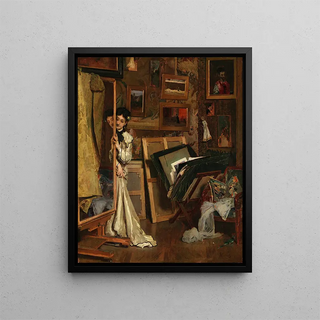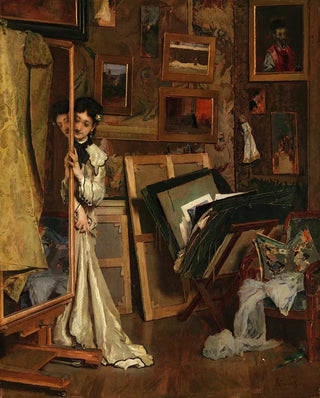Art print | Le Psyché Mon Studio - Alfred Stevens


View from behind

Frame (optional)
In the rich and diverse panorama of art history, some works manage to capture the very essence of their era while transcending time. "Le Psyché Mon Studio" by Alfred Stevens is undoubtedly one of these creations. This painting, which delicately evokes the beauty and complexity of human emotions, invites the viewer to immerse themselves in a universe where the delicacy of features and the depth of gazes meet. The scene depicted by Stevens, imbued with palpable intimacy, transports us to a suspended moment, where time seems to stand still to make way for contemplation.
Style and uniqueness of the work
Alfred Stevens's style is characterized by striking realism, meticulous attention to detail, and mastery of light play that gives his works a unique atmosphere. In "Le Psyché Mon Studio," every element is carefully crafted, from the textures of the clothing to the reflections in the mirror, creating a visual harmony that captivates the eye. The artist excels in depicting female figures, portrayed with unmatched grace and elegance. The composition, both balanced and dynamic, demonstrates a deep understanding of space and perspective. This painting, through its subtle treatment of emotions and human interactions, manages to establish a silent dialogue between the subject and the observer, inviting each to interpret the story unfolding before their eyes.
The artist and his influence
Alfred Stevens, an emblematic figure of the 19th century, knew how to carve out a prominent place within the realist movement. His career, marked by travels across Europe, allowed him to absorb various influences while developing a distinctive style. His works, often focused on everyday life and female concerns, reveal a particular sensitivity to the human condition. Stevens is not just a painter; he is an observer of his time, a chronicler of morals and societal aspirations. His influence is felt not only in his own work but also among many contemporary and later artists inspired by his ability to capture the essence of modern life. By redefining the representation of women in art

Matte finish

View from behind

Frame (optional)
In the rich and diverse panorama of art history, some works manage to capture the very essence of their era while transcending time. "Le Psyché Mon Studio" by Alfred Stevens is undoubtedly one of these creations. This painting, which delicately evokes the beauty and complexity of human emotions, invites the viewer to immerse themselves in a universe where the delicacy of features and the depth of gazes meet. The scene depicted by Stevens, imbued with palpable intimacy, transports us to a suspended moment, where time seems to stand still to make way for contemplation.
Style and uniqueness of the work
Alfred Stevens's style is characterized by striking realism, meticulous attention to detail, and mastery of light play that gives his works a unique atmosphere. In "Le Psyché Mon Studio," every element is carefully crafted, from the textures of the clothing to the reflections in the mirror, creating a visual harmony that captivates the eye. The artist excels in depicting female figures, portrayed with unmatched grace and elegance. The composition, both balanced and dynamic, demonstrates a deep understanding of space and perspective. This painting, through its subtle treatment of emotions and human interactions, manages to establish a silent dialogue between the subject and the observer, inviting each to interpret the story unfolding before their eyes.
The artist and his influence
Alfred Stevens, an emblematic figure of the 19th century, knew how to carve out a prominent place within the realist movement. His career, marked by travels across Europe, allowed him to absorb various influences while developing a distinctive style. His works, often focused on everyday life and female concerns, reveal a particular sensitivity to the human condition. Stevens is not just a painter; he is an observer of his time, a chronicler of morals and societal aspirations. His influence is felt not only in his own work but also among many contemporary and later artists inspired by his ability to capture the essence of modern life. By redefining the representation of women in art






